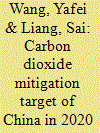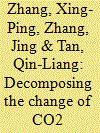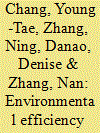|
|
|
Sort Order |
|
|
|
Items / Page
|
|
|
|
|
|
|
| Srl | Item |
| 1 |
ID:
122748


|
|
|
|
|
| Publication |
2013.
|
| Summary/Abstract |
The potential of agricultural residues has been assessed worldwide and at different scales. Interpreting results so as to determine the possible role of this biomass feedstock in energy supplies, requires a clearer understanding of the conditions in which residues can effectively be mobilized for energy production. The experience of India with hundreds of projects where agricultural residues are transformed to heat and power partially sold to the grid, is analyzed and checked against the residue potentials that have been assessed in this country. We find that, in the absence of technological improvements in biomass conversion, the apparent success of Indian bioenergy projects is not sustainable in the long run due to rapid exhaustion effects on residue availability, coupled with the increasing costs that would be difficult to compensate by higher electricity tariffs. We also identify there is a serious agricultural issue which needs to be addressed in regard to degraded soils; this could lead to the reallocation of all primary residues, as well as part of secondary residues to soil and livestock needs. Such perspectives are considered within three contrasted scenario storylines.
|
|
|
|
|
|
|
|
|
|
|
|
|
|
|
|
| 2 |
ID:
122716


|
|
|
|
|
| Publication |
2013.
|
| Summary/Abstract |
Production of renewable energy from biomass has been promoted as means to improve greenhouse gas balance in energy production, improve energy security, and provide jobs and income. However, uncertainties remain as to how the agriculture and forest sectors might jointly respond to increased demand for bioelectricity feedstocks and the potential environmental consequences of increased biomass production. We use an economic model to examine how the agriculture and forest sectors might combine to respond to increased demands for bioelectricity under simulated future national-level renewable electricity standards. Both sectors are projected to contribute biomass, although energy crops, like switchgrass, produced on agriculture land are projected to be the primary feedstocks. At the highest targets for bioelectricity production, we project increased conversion of forest to agriculture land in support of agriculture biomass production. Although land conversion takes place in response to renewable electricity mandates, we project only minor increases in forest and agriculture emissions. Similarly, crop prices were projected to generally be stable in the face of increased bioelectricity demand and displacement of traditional agriculture crops.
|
|
|
|
|
|
|
|
|
|
|
|
|
|
|
|
| 3 |
ID:
122740


|
|
|
|
|
| Publication |
2013.
|
| Summary/Abstract |
As the capital of China, Beijing is regarded as a major metropolis in the world. Study of the variation in temporal CO2 emissions generated by the driving forces in Beijing can provide guidance for policy decisions on CO2 emissions mitigation in global metropolises. Based on input-output structural decomposition analysis (IO-SDA), we analysed the driving forces for the increment in CO2 emissions in Beijing from both production and final demand perspectives during 1997-2010. According to our results, the CO2 emission growth in Beijing is driven mainly by production structure change and population growth, partly offset by CO2 emission intensity reduction as well as the decline in per capita final demand volume during the study period. Final demand structure change has a limited effect on the change in the CO2 emissions in Beijing. From the final demand perspective, urban trades, urban residential consumption, government consumption and fixed capital formation are mainly responsible for the booming emissions. This study showed how the "top-down" IO-SDA methodology was implemented on a city scale. Policy implications from this study would be helpful for addressing CO2 emissions mitigation in global capital cities and metropolises.
|
|
|
|
|
|
|
|
|
|
|
|
|
|
|
|
| 4 |
ID:
122718


|
|
|
|
|
| Publication |
2013.
|
| Summary/Abstract |
China proposed a CO2 mitigation target in 2020 to deal with anthropogenic global climate change. Chinese policy makers mainly focus on three factors comprising consumption structure changes, energy technology development, and new energy increments. In addition, sectoral CO2 reduction is increasingly concerned in the world. Thus, it is significant to investigate integrated impacts of three factors to China's CO2 mitigation target as well as to identify key economic sectors for achieving this target. In this study, energy demand and CO2 emission in 2020 are predicted. Five scenarios are generated to illustrate the contributions of three factors. In addition, twelve key economic sectors for reducing energy demand and CO2 emission are identified from both production and final demand perspectives. Under integrated impacts of three factors, China's CO2 intensity per unit gross domestic product in 2020 will decrease by about 43.9% in 2020 than 2005 level. In the short term, China's CO2 mitigation will be highly dependent on energy technology development. In the long term, it will mainly rely on reshaped consumption structure changes and new energy development. In addition, China's future policies should focus on 12 identified key economic sectors.
|
|
|
|
|
|
|
|
|
|
|
|
|
|
|
|
| 5 |
ID:
122720


|
|
|
|
|
| Publication |
2013.
|
| Summary/Abstract |
Most energy generation globally is fueled by coal and oil, raising concerns about greenhouse gas emissions. Hydroelectric reservoirs are anthropogenic aquatic systems that occur across a wide geographical extent, and, in addition to their importance for energy production, they have the potential to release two important greenhouse gases (GHGs), carbon dioxide and methane. We report results from an extensive study of eight hydroelectric reservoirs located in central and southeastern tropical Brazil. In the Brazilian dry tropical biome reservoirs, emissions (in tons of CO2 Eq. per MW h) varied from 0.01 to 0.55, and decreased with reservoir age. Total emissions were higher in the reservoir lake when compared to the river downstream the dam; however, emissions per unit area, in the first kilometer of the river after the dam, were higher than that in the reservoir. The results showed, despite higher carbon emissions per energy production in the youngest reservoirs, lower emission from hydroelectric reservoirs from the studied region in relation to thermo electrical supply, fueled by coal or fossil fuel. The ratio emission of GHG per MWh produced is an important parameter in evaluating the service provided by hydroelectric reservoir and for energy planning policies.
|
|
|
|
|
|
|
|
|
|
|
|
|
|
|
|
| 6 |
ID:
122734


|
|
|
|
|
| Publication |
2013.
|
| Summary/Abstract |
This study examines the effects of the inclusion of the co-benefits on the potential installed capacity of carbon dioxide capture and storage (CCS) projects with a linear programming model by the clean development mechanism (CDM) in India's power sector. It is investigated how different marginal damage costs of air pollutants affect the potential installed capacity of CCS projects in the CDM with a scenario analysis. Three results are found from this analysis. First, large quantity of IGCC with CCS becomes realizable when the certified emission reduction (CER) prices are above US$56/tCO2 in the integrated Northern, Eastern, Western, and North-Eastern regional grids (NEWNE) and above US $49/tCO2 in the Southern grid. Second, including co-benefits contributes to decrease CO2 emissions and air pollutants with introduction of IGCC with CCS in the CDM at lower CER prices. Third, the effects of the co-benefits are limited in the case of CCS because CCS reduces larger amount of CO2 emissions than that of air pollutants. Total marginal damage costs of air pollutants of US$250/t and US$200/t lead to CER prices of US$1/tCO2 reduction in the NEWNE grid and the Southern grid.
|
|
|
|
|
|
|
|
|
|
|
|
|
|
|
|
| 7 |
ID:
122712


|
|
|
|
|
| Publication |
2013.
|
| Summary/Abstract |
Reducing the energy consumption of buildings is an important goal for the European Union. However, it is therefore of interest to investigate how different member states address these goals. Countries like Sweden and Germany have developed different strategies for energy conservation within the building sector. A longitudinal comparison between implemented energy conservation key policy instruments in Sweden and Germany and a survey regarding the management of energy requirements in the building process shows that:
-
No evidence is found that energy consumption is of great importance for producing competitive offers, either for Swedish or German clients.
-
The Swedish market-driven policy has not been as successful as the German regulation policy in decreasing the energy consumption of new buildings.
-
Building standards and regulations regarding energy performance affects how professionals are educated and the way energy requirements and demands are managed throughout the building process.
In conclusion, the client's demand will govern the development of energy efficient buildings. Therefore, in order to use market-driven policies, the desired parameters must be of concern for the customer to influence the majority of building projects to be more energy efficient than is specified in national standards and regulations.
|
|
|
|
|
|
|
|
|
|
|
|
|
|
|
|
| 8 |
ID:
122742


|
|
|
|
|
| Publication |
2013.
|
| Summary/Abstract |
This paper presents an alternative decomposition method to explore the driving forces of change in carbon emissions by using distance functions estimated by data envelopment analysis. The proposed approach can isolate the effects of changes in GDP composition and energy supply composition on the change of carbon emissions. In addition, it is capable of identifying the effects of changes in different input ratios, which may be very important if there are substitution effects among different inputs. Moreover, the proposed model can measure the effects of changes in good and bad output technical efficiencies. Consequently, this decomposition technique allows a change of carbon emissions to be decomposed into contributions from ten factors, which provides more insights for policy makers. We apply this model to decompose carbon emissions in 25 OECD counties and China. For the sample countries as a whole, the empirical results indicate that the economic growth is the crucial driver to carbon emissions increase, while the changes in GDP composition and capital-energy ratio are two main drivers to carbon emissions reduction. In particular, we discuss in detail the driving forces of China's carbon emissions change in order to propose some valuable policy implications for China from an international perspective.
|
|
|
|
|
|
|
|
|
|
|
|
|
|
|
|
| 9 |
ID:
122731


|
|
|
|
|
| Publication |
2013.
|
| Summary/Abstract |
The pace of development of shale gas plays varies greatly among US states and globally. Through analysis of telephone survey responses, we explore support for natural gas drilling in residents of Washington County (WC), PA (n=502) vs. residents of Allegheny County (AC), PA (n=799). WC has had intense Marcellus Shale (MS) drilling activity, in comparison to adjacent AC, which has had little drilling activity. WC residents are marginally more supportive of MS drilling than are AC residents (p=0.0768). Residents of WC are more likely to perceive MS as an economic opportunity than are AC residents (p=0.0015); to be in a family that has signed a MS lease (p<0.0001); to follow the MS issue closely (p=0.0003); to get MS information from neighbors, friends, and relatives (p<0.0001); and are marginally less likely to perceive MS as an environmental threat (p=0.1090). WC leaseholders are significantly more supportive of MS drilling than WC non-leaseholders and AC non-leaseholders (p=0.0024). Mediation analyses show that county-based differences in support of MS drilling are due to WC residents seeing more of an economic opportunity in the MS and their greater likelihood of having a family-held lease.
|
|
|
|
|
|
|
|
|
|
|
|
|
|
|
|
| 10 |
ID:
122737


|
|
|
|
|
| Publication |
2013.
|
| Summary/Abstract |
The industrial sector has accounted for more than 50% of China's final energy consumption in the past 30 years. Understanding the future emissions and emissions mitigation opportunities depends on proper characterization of the present-day industrial energy use, as well as industrial demand drivers and technological opportunities in the future. Traditionally, however, integrated assessment research has handled the industrial sector of China in a highly aggregate form. In this study, we develop a technologically detailed, service-oriented representation of 11 industrial subsectors in China, and analyze a suite of scenarios of future industrial demand growth. We find that, due to anticipated saturation of China's per-capita demands of basic industrial goods, industrial energy demand and CO2 emissions approach a plateau between 2030 and 2040, then decrease gradually. Still, without emissions mitigation policies, the industrial sector remains heavily reliant on coal, and therefore emissions-intensive. With carbon prices, we observe some degree of industrial sector electrification, deployment of CCS at large industrial point sources of CO2 emissions at low carbon prices, an increase in the share of CHP systems at industrial facilities. These technological responses amount to reductions of industrial emissions (including indirect emission from electricity) are of 24% in 2050 and 66% in 2095.
|
|
|
|
|
|
|
|
|
|
|
|
|
|
|
|
| 11 |
ID:
122745


|
|
|
|
|
| Publication |
2013.
|
| Summary/Abstract |
Plug-in hybrid electric vehicles (PHEVs) use grid electricity as well as on-board gasoline for motive force. These multiple energy sources make prediction of PHEV energy consumption challenging and also complicate evaluation of their environmental impacts. This paper introduces a novel PHEV energy consumption modeling approach and compares it to a second approach from the literature, each using actual trip patterns from the 2009 National Household Travel Survey (NHTS). The first approach applies distance-dependent fuel efficiency and on-road electricity consumption rates based on naturalistic or real world, driving information to determine gasoline and electricity consumption. The second uses consumption rates derived in accordance with government certification testing. Both approaches are applied in the context of a location-specific case study that focuses on the state of Michigan. The two PHEV models show agreement in electricity demand due to vehicle charging, gasoline consumption, and life cycle environmental impacts for this case study. The naturalistic drive cycle approach is explored as a means of extending location-specific driving data to supplement existing PHEV impact assessments methods.
|
|
|
|
|
|
|
|
|
|
|
|
|
|
|
|
| 12 |
ID:
122736


|
|
|
|
|
| Publication |
2013.
|
| Summary/Abstract |
Many countries are worried about reducing energy consumption and environmental pollution while increasing the productivity and efficiency of their industries. This study intends to contribute to the literature by proposing a non-radial DEA model with the slacks-based measure (SBM) to analyze the environmental efficiency of China's transportation sector. The results show that most of the provinces in China do not have an eco-efficient transportation industry. The environmental efficiency levels in most of the provinces are lower than 50% of the ideal or target level. Therefore, China's transportation industry is environmentally very inefficient. China can reduce a great deal of carbon emissions in each province ranging from at least 1.6 million TOEs in Qinghai and at most 33 million TOEs in Guangdong and Shanghai.
|
|
|
|
|
|
|
|
|
|
|
|
|
|
|
|
| 13 |
ID:
122739


|
|
|
|
|
| Publication |
2013.
|
| Summary/Abstract |
The present study provides insights into how the national legislation affected the development of connected to the grid Photovoltaic (PV) systems in Greece from January 2007 to June 2012. It analyses the evolution of PV systems installed capacity in Greece, compared to the targets set, as well as the PV electricity production and CO2 emissions reduction. Moreover the geographical and the size distribution of installed capacity are examined. Up to June 2012, more than 820 MWp had been installed, covering 55% of the 2014 national PV target capacity of 1500 MWp. The majority of installed and licensed PV systems is in the class of 20-150 kWp, while the share of PV systems larger than 150 kWp is increasing steadily. The majority of installed capacity is located in southern Greece regions, where the solar potential is higher, with Peloponnesus having 15.4% of the total. The total licensed PV capacity, which is more than 2.400 MWp exceeding not only the national 2014 target but also the 2020 target of 2200 MWp for PV plants, together with the accelerated construction rate, which during 2012 is 49 MWp per month, allow the save prediction that the 2014 target will be overcome.
|
|
|
|
|
|
|
|
|
|
|
|
|
|
|
|
| 14 |
ID:
122733


|
|
|
|
|
| Publication |
2013.
|
| Summary/Abstract |
Spatial variation of solar energy is crucial for the estimation of the regional potential and selection of construction location. This paper presents a case study of using high resolution grid map of solar radiation combined with the other restriction factors to evaluate the comprehensive potential analysis of solar PV generation at the regional scale, in order to present a framework of decision support tool for solar energy management in a regional area. The cost of PV generation is calculated based on the geographical distribution of technical potential. Moreover, geospatial supply curve (GSC) is employed to portray the evolution of available potential of photovoltaics (PV) generation with the increase of the generation cost. By integrating the economic evaluation variables of net present value and simple payback period, grid-based economic feasibility of PV generation project is then carried out under two feed-in-tariff scenarios. Finally, total CO2 reduction potential and its spatial distribution in the study area are calculated. The results confirm that PV technology provides high potential for roof-top application and large-scale PV stations. Additionally, determining a reasonable feed-in tariff is essential for expanding the application of solar PV energy. The findings improve understanding of regional renewable energy strategies and the supply/demand assessment.
|
|
|
|
|
|
|
|
|
|
|
|
|
|
|
|
| 15 |
ID:
122724


|
|
|
|
|
| Publication |
2013.
|
| Summary/Abstract |
The objective of this study was to compare the fuel-chain greenhouse gas balance and farm economics of hemp grown for bioenergy with two perennial bioenergy crops, Miscanthus and willow, and two more traditional annual bioenergy crops, sugar beet and oil seed rape (OSR). The GHG burden of hemp cultivation is intermediate between perennial and traditional annual energy crops, but net fuel chain GHG abatement potential of 11 t/CO2 eq./ha/year in the mid yield estimate is comparable to perennial crops, and 140% and 540% greater than for OSR and sugar beet fuel chains, respectively. Gross margins from hemp were considerably lower than for OSR and sugar beet, but exceeded those from Miscanthus when organic fertilizers were used and in the absence of establishment grants for the latter crop. Extrapolated up to the EU scale, replacing 25% of OSR and sugar beet production with hemp production could increase net GHG abatement by up to 21 Mt CO2eq./year. Hemp is a considerably more efficient bioenergy feedstock than the dominant annual energy crops. Integrated into food crop rotations, hemp need not compete with food supplies, and could provide an appealing option to develop more sustainable non-transport bioenergy supply chains.
|
|
|
|
|
|
|
|
|
|
|
|
|
|
|
|
| 16 |
ID:
122710


|
|
|
|
|
| Publication |
2013.
|
| Summary/Abstract |
This paper analyzes the impact of electricity storage on the production cost of a power system and the marginal cost of electricity (electricity price) using a unit commitment model. Also, real world data has been analyzed to verify the effect of storage operation on the electricity price using econometric techniques. The unit commitment model found that the deployment of a storage system reduces the fuel cost of the power system but increases the average electricity price through its effect on the power system operation. However, the reduction in the production cost was found to be less than the increase in the consumer's cost of electricity resulting in a net increase in costs due to storage. Different storage and CO2 price scenarios were investigated to study the sensitivity of these results. The regression analysis supports the unit commitment results and finds that the presence of storage increases average wholesale electricity prices for the case study system.
|
|
|
|
|
|
|
|
|
|
|
|
|
|
|
|
| 17 |
ID:
122743


|
|
|
|
|
| Publication |
2013.
|
| Summary/Abstract |
Norway has some of the best wind resources in Europe. In 1999, the Norwegian Parliament committed to attain an annual onshore wind power production goal of 3.0 TWh by 2010; however, in 2010, onshore wind power production measured only 1.0 TWh. This article discusses the reasons that this goal was not achieved. The analysis addresses the key figures on the strategic, tactical and operational levels. This model is combined with a time line that seeks to define when different actors should have secured concessions1 and funding to achieve the goal. After introducing the time line, a list of questions is introduced for these key actors. The three-level model, the time line and the questions constitute the analytical framework. Explanations for the failure to achieve the goal may be identified on all three levels. However, the primary explanatory factors were political uncertainty in the support scheme and wind power's role in the energy market in general; both of these factors are identified on the strategic level. Uncertainty on the strategic level influenced the lower levels, which led to bottlenecks in the concession process and jittery investors who thought that the risk of investment in wind power was too high.
|
|
|
|
|
|
|
|
|
|
|
|
|
|
|
|
| 18 |
ID:
122732


|
|
|
|
|
| Publication |
2013.
|
| Summary/Abstract |
In many countries, investments in renewable technologies have been accelerated by fixed feed-in tariffs for electricity from renewable energy sources (RES). While fixed tariffs accomplish this purpose, they lack incentives to align the RES production with price signals. Today, the intermittency of most RES increases the volatility of electricity prices and makes balancing supply and demand more complicated. Therefore, support schemes for RES have to be modified. Recently, Germany launched a scheme which gives wind power operators the monthly choice to either receive a fixed tariff or to risk a - subsidized - access to the wholesale electricity market. This paper quantifies revenues of wind turbines under this new subsidy and analyzes whether, when and where producers may profit. We find that the position of the wind turbine within the country significantly influences revenues in terms of EUR/MWh. The results are important for wind farm operators deciding whether electricity should be sold in the fixed feed-in tariff or in the wholesale market. However, no location is persistently, i.e., in every calendar month of the year, above the average. This limits the effect of the new subsidy scheme on investment locations and long term improvements in the aggregated wind feed-in profile.
|
|
|
|
|
|
|
|
|
|
|
|
|
|
|
|
| 19 |
ID:
122746


|
|
|
|
|
| Publication |
2013.
|
| Summary/Abstract |
Climate science suggests that, to have a high probability of limiting global warming to an average temperature increase of 2 °C, global greenhouse gas emissions must peak by 2020 and be reduced to close to zero by 2040. However, the current trend is heading towards at least 4 °C by 2100 and little effective action is being taken. This paper commences the process of developing contingency plans for a scenario in which a sudden major global climate impact galvanises governments to implement emergency climate mitigation targets and programs. Climate activists assert that rapid mitigation is feasible, invoking the scale and scope of wartime mobilisation strategies. This paper draws upon historical accounts of social, technological and economic restructurings in several countries during World War 2 in order to investigate potential applications of wartime experience to radical, rigorous and rapid climate mitigation strategies. We focus on the energy sector, the biggest single contributor to global climate change, in developed and rapidly developing countries. We find that, while wartime experience suggests some potential strategies for rapid climate mitigation in the areas of finance and labour, it also has severe limitations, resulting from its lack of democratic processes.
|
|
|
|
|
|
|
|
|
|
|
|
|
|
|
|
| 20 |
ID:
122713


|
|
|
|
|
| Publication |
2013.
|
| Summary/Abstract |
Energy security concerns due to high oil import dependence and climate change concerns due to related greenhouse gas emissions are important policy discussions in India. Could life cycle assessment (LCA) of petroleum oil products provide inputs to crude oil sourcing and domestic oil pricing policies to address the two concerns? This paper presents a baseline study on LCA of petroleum products in India from Well to Storage depending on the oil source, type of refinery, product and the selected destinations. The LCA based GHG emissions are found to be higher by 4-12 per cent than GHG emissions from direct fuel consumption alone for LPG, 7-10 per cent for Gasoline, 3-9 per cent for Diesel and 4-10 per cent for Kerosene based on various supply chain routes supplying oil to six largest cities in India. Overall the energy used in oil exploration, refinery and transportation in the LCA have a share of 72-77 per cent, 11-15 per cent and 6-8 per cent, respectively. The paper proposes imposing a relative carbon cess for various oil products in different Indian cities. States could accommodate this additional carbon cess by reducing their respective state taxes without increasing the final delivery price to the consumers.
|
|
|
|
|
|
|
|
|
|
|
|
|
|
|
|
|
|
|
|
|